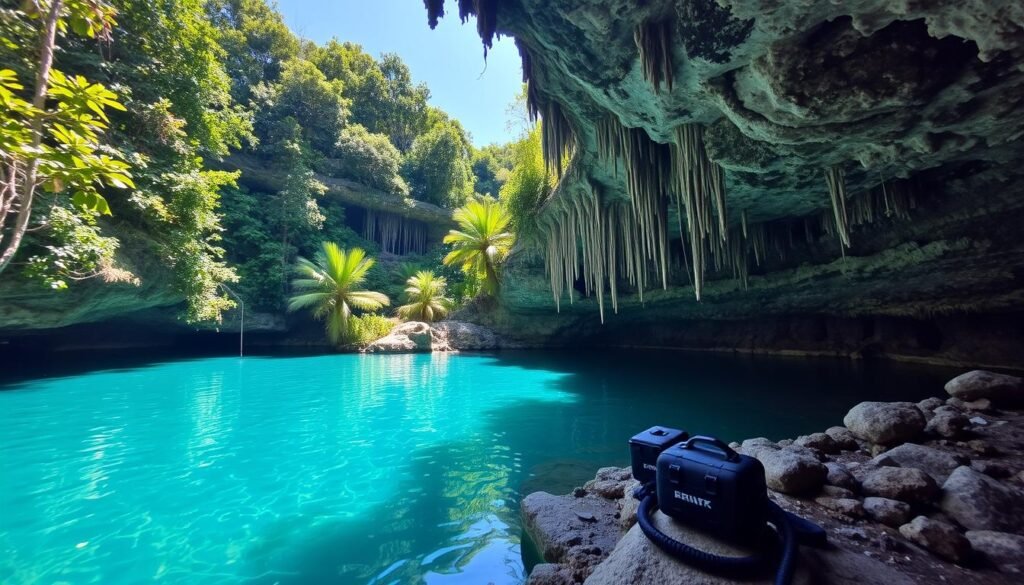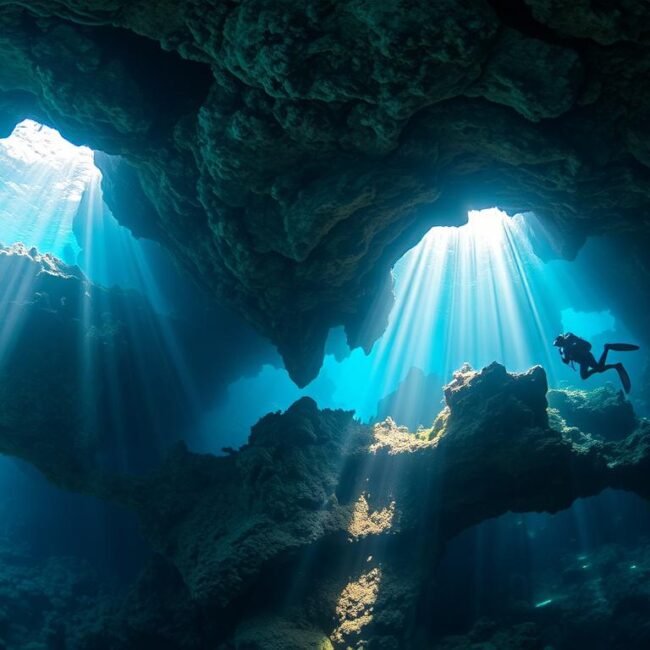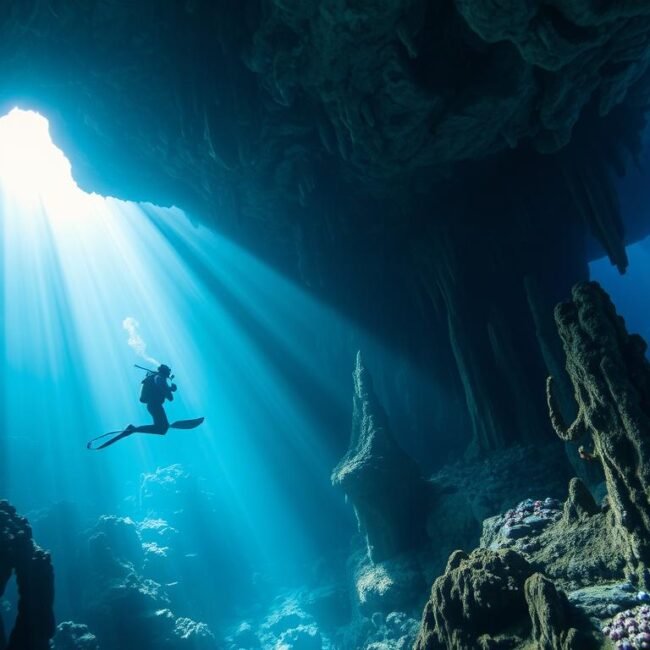Welcome to the magical world beneath Mexico’s limestone surface! Did you know the Yucatán Peninsula has over 6,000 cenotes? Many offer exciting cave diving. I’ve explored these hidden spots and found the right gear is key! Get ready for the best cave diving gear for Mexico, turning any dive into an unforgettable journey.
Choosing the Perfect Wetsuit and Exposure Protection for Mexican Waters
When I first planned my cave diving trips in Mexico, picking a wetsuit was tough. I once wore a 3mm full suit in cool water and shivered like crazy! It taught me choosing the right exposure protection is crucial. Mexico’s cave diving conditions vary, so let’s explore what to consider.
Picking the Right Thickness
Mexican cenotes are usually around 75°F (24°C), but can feel colder after diving. A 3mm wetsuit might be fine for some, but if you get cold easily, go for a 5mm. Switching to a 5mm wetsuit mid-trip made a huge difference for me. I could enjoy the stunning stalactites without worrying about my teeth chattering.
Comfort and Flexibility Matter
It’s not just about thickness. You need a suit that’s flexible for easy movement. I once wore a stiff suit and it was a disaster. Now, I choose brands known for comfort. A well-fitting wetsuit helps you stay focused underwater, not distracted by discomfort.
Balancing Warmth and Freedom
Too thick, and you can’t move. Too thin, and you’ll freeze. Find a balance that fits your body and dive style. For me, a 5mm wetsuit with a hood is perfect. Others might prefer a 3mm with a shorty layering piece. Experiment to find what works best for you.
Top Brands and Trusted Gear
Some wetsuit brands are favorites among Mexican cave divers. Henderson, Bare, and Cressi are popular. I’ve dived with Henderson suits and they’re great against limestone edges. Quick-drying linings are also a plus, making the second dive more enjoyable.
Tips Learned the Hard Way
Don’t skimp on quality. A good wetsuit lasts longer and feels better. Always rinse it in fresh water and dry it in the shade. A moldy, smelly suit is a bummer. Take care of your gear, and it will take care of you.
Choosing the right wetsuit for Mexico is more than just a number. It’s about the temperature, comfort, thickness, and the brand’s quality. Once you find the perfect fit, you can enjoy the beauty of cenotes without worrying about the cold.
Essential Buoyancy Control Devices (BCD) and Backplate Systems
Buoyancy control is key to my cave diving confidence. Imagine gliding through a passage and suddenly hitting your tank on the ceiling, stirring up silt. It’s not a good feeling. I learned that a good BCD or backplate system is essential for staying stable.
Why Buoyancy Matters in Tight Spaces
Cenote caves are tight, with narrow corridors and delicate formations. Without proper buoyancy, you might bump into walls or damage formations. A good BCD lets you control your buoyancy, making diving feel like flying.
Jacket-Style BCDs vs. Backplate-and-Wing Systems
I started with a jacket BCD but found it bulky. Switching to a backplate-and-wing system made a huge difference. It streamlines your profile and makes diving easier.
Streamlining Your Setup
In cave diving, simplicity is best. Remove unnecessary gear and keep everything close to your body. A well-calibrated wing helps you achieve neutral buoyancy easily. Avoiding over-inflation is crucial to avoid accidents.
Adjusting Lift Capacity for Cave Scenarios
Consider the depth, duration, and gear you’ll carry. A smaller wing is good for light travel, while a larger one is better for extra equipment. Experimenting during training dives helps find the right fit.
Choosing Brands and Maintenance
Choose trusted brands like Halcyon, Dive Rite, and OMS. They make durable gear. Remember to maintain your BCD after each dive. A small tear can ruin your day. Regular checks can prevent big problems.
A good BCD or backplate system can change your cave diving experience in Mexico. It helps you avoid damaging formations, saves energy, and makes diving more enjoyable. It’s a worthwhile investment for every dive.
High-Quality Dive Lights and Torches for Low-Visibility Environments
When it comes to cave diving, your dive light is crucial. These dives take you into dark passages where you can’t see a thing. You need a reliable primary light and backup torches.
Why Primary and Backup Lights Matter
Your primary light is your main light source in these dark caves. It should be bright, durable, and last long. But, always have a backup light ready. I once had my primary light fail, and having a spare saved me from darkness.
Beam Angles and Brightness in Caves
In caves, you’re not just looking for fish. You’re checking the rocks and your line. A focused beam helps cut through the water and silt. Aim for around 1000 lumens for enough light without blinding your buddy.
Rechargeable vs. Disposable Batteries
I switched to rechargeable batteries for easier and greener diving. Make sure to charge them fully before diving. Running out of battery mid-dive is not fun. Rechargeables save money and are reliable.
Durable Brands Worth Checking Out
Brands like Light & Motion, Halcyon, and Dive Rite are favorites among cave divers. My Halcyon light has been on many dives and still works great. Choose durable lights to withstand cave diving’s rough conditions.
Maintenance and Care
Clean your lights with fresh water after each dive. Check O-rings for damage. A small crack can cause a flood. Store lights in a cool, dry place and test them before diving.
With the right dive lights, cave diving in Mexico’s cenotes becomes more enjoyable. You’ll light up the path, see the scenery, and have an amazing dive.
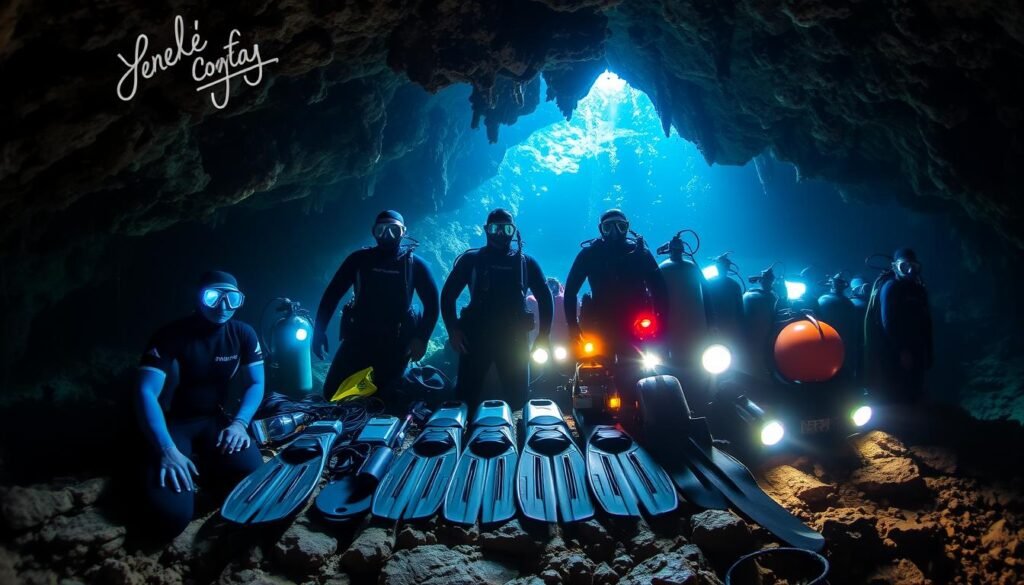
Reels, Spools, and Cavern Lines for Safe Navigation
When I first started cave diving, I thought I knew my way around. But, I was wrong. Without the right tools like guideline reels and cavern lines, getting lost is easy. It’s scary not knowing how to find your way back.
Guideline Reels: Your Lifeline in Complex Caves
A guideline reel is like a trail you leave behind. You start at the entrance and follow it back. It’s simple, but only if done right. A tangled reel can cause big delays.
Choosing Materials That Resist Tangles and Abrasion
You need line that’s tough and won’t break easily. Look for high-quality, cave-specific line. Cheap fishing line is not good enough. It can get tangled and waste time.
Techniques for Laying and Retrieving Line
Practice in open water before caves. Learn to tie off at stable points. Keep the line tight but not too tight. Slowly rewind to avoid knots.
Safe Line Management Before Challenging Systems
Practice in simpler caves before tackling harder ones. Dry runs help you learn what to do in emergencies. I practiced until I could do it with my eyes closed.
Tips Learned Through Trial and Error
Always carry extra line and a spool. Keep a cutting tool for snags. Mark lines so you know which way is out. I once followed the wrong line and wasted 10 minutes.
In short, reels, spools, and cavern lines are key for safe cave diving. With practice and the right gear, navigating caves becomes easy. Soon, you’ll enjoy the underwater world like never before.
Fins, Masks, and Snorkels for Optimal Performance Underwater
One of my first mistakes was using the wrong fins. They were great for the open ocean but not for caves. The right gear makes a big difference in your dive.
Fins That Offer Efficiency and Precision
In caves, space is tight, and big kicks can cloud the water. You need fins that let you move quietly and precisely. I switched to shorter, stiffer fins for better control. Now, I can make small movements and avoid stirring up the water.
Masks with Wide Fields of View and Low Volume
A good mask is almost invisible. Low-volume masks are easier to clear and less likely to leak. They also offer a wide view, essential for spotting line arrows and signals in dark caves. I once wore a bulky mask that hurt my forehead. It left a mark for hours.
Avoiding Unnecessary Snorkels
Snorkels are great for surface swims in open water. But in caves, they’re a hindrance. Most cave divers leave them behind. I once brought mine and it got tangled with my mask straps. It was a hassle.
Proper Fit and Maintenance
Always check your gear before diving. Make sure your mask and fin straps fit right. A broken fin strap can make swimming hard. Rinse your gear after diving to prevent damage.
Personal Favorites and Suggestions
Mares, Scubapro, and Atomic are popular among cave divers. I prefer Atomic’s low-volume mask. For fins, stiff paddle fins work best for me. Try different models to find what works for you.
Choosing the right fins, mask, and avoiding snorkels improves your cave diving. These changes help you control your movements, see clearly, and enjoy the dive more.
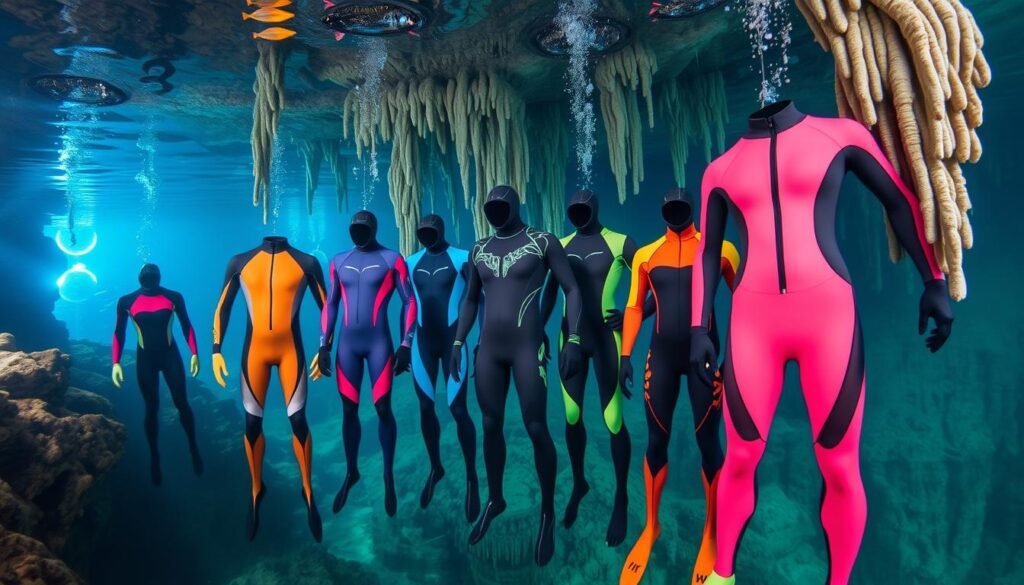
Reliable Regulators and Air Delivery Systems
Regulators and air systems are your life support in caves. A reliable setup is crucial. I once dove with a faulty regulator that free-flowed at depth. It was a scary experience.
Smooth Breathing at Depth
A good regulator delivers air smoothly, even at great depths. Balanced regulators provide consistent airflow. Unbalanced ones can make breathing harder as the tank pressure drops. I prefer balanced regulators for easy breathing.
Balanced vs. Unbalanced Regulators in Caves
Balanced regulators are best for cave diving. They make diving easier. When you’re in a tight spot, you don’t want a finicky regulator.
I tried an unbalanced reg once and regretted it. It made breathing harder. Don’t save money by risking your comfort.
DIN or Yoke Connections for Mexican Conditions
Mexico often uses DIN fittings because they’re more secure. I switched to DIN after a bad experience with Yoke. DIN fittings are threaded and stable.
Yoke can work too, but DIN is safer. Since switching, I’ve had no issues.
Regular Servicing for Safety and Longevity
A regulator needs regular care. Get it serviced every year or more if you dive a lot. I once ignored my reg’s needs and it started breathing wet.
After a service, it felt new again. Carry spare O-rings and know how to fix small problems. A small kit can save your dive.
Choosing Your Brand and Model
Brands like Apeks, Scubapro, and Atomic are great for cave diving. They’re built to last. Dive Rite is also popular among cave divers.
Choose a reg that feels right and breathes well. Test it in shallow water before diving in caves. Safety first.
In short, a reliable regulator lets you enjoy diving. It’s crucial to not cut corners. Take care of your reg, and it will take care of you.
Dive Computers, Compasses, and Navigation Tools
Cave diving in Mexico feels like exploring another planet. Your usual sense of direction won’t help much. That’s why having the right navigation tools is crucial. Dive computers, compasses, and other gadgets can be game-changers.
I remember my first complex cave system. I thought I could just rely on my buddy and gut feeling. But I almost got us lost. After that, I learned to trust my gear.
Essential Dive Computer Functions
A good dive computer tracks depth, bottom time, and sometimes even includes a digital compass. In caves, you dive deeper than you think, and time seems to warp. A reliable computer ensures you don’t overstay your welcome and avoid decompression sickness.
I prefer computers with large, clear displays and simple menus. Nothing’s worse than squinting at tiny buttons while hovering over delicate formations. Some advanced computers track multiple gasses for technical diving. That’s overkill for beginners but nice to have.
Using Compasses in Dark Passages
A compass in a cave might seem silly at first. But it can still help maintain direction or verify your route. I once doubted my line-laying and checked my compass to confirm the exit route. It’s not the main tool but a handy backup.
Just remember that metal objects and some cave structures can mess with the compass reading. Test it outside to see how it behaves.
Pairing Digital Navigation Aids with Physical Guidelines
No matter how fancy your computer or compass is, guidelines are your top navigation method in caves. But tech can complement them. For instance, if you mark your time at certain line junctions and confirm depth with your computer, you’ll know if you’re retracing your steps correctly. I once used my computer’s timer to figure out how long it took to reach a certain landmark, then confirmed it on the way back. It felt like a tiny victory when everything matched up perfectly.
Backing Up Your Data and Redundancies
Sometimes electronics fail. Batteries die, screens glitch. It happens. That’s why you have redundant tools: a backup computer or a simple depth gauge and timer. I carry a small wrist slate to jot down critical info too. Once, my computer decided to freeze mid-dive. I had recorded depth and time intervals on my slate earlier and knew roughly where I stood. Having a backup plan saved me from guessing and risking my safety.
Selecting Trustworthy Brands
Names like Shearwater, Suunto, and Garmin are popular for dive computers. Suunto’s user-friendly interfaces and robust builds have impressed me over the years. For compasses, you can’t go wrong with a basic model from a reputable dive gear manufacturer. Just ensure you know how to calibrate and interpret it under tricky conditions.
In the end, dive computers, compasses, and navigation tools complement your line-laying and natural navigation skills. They add layers of safety and confidence, helping ensure that you spend your cave dive marveling at hidden wonders rather than panicking about where you are. It’s all about blending old-school techniques with modern tech to become a well-rounded cave diver.
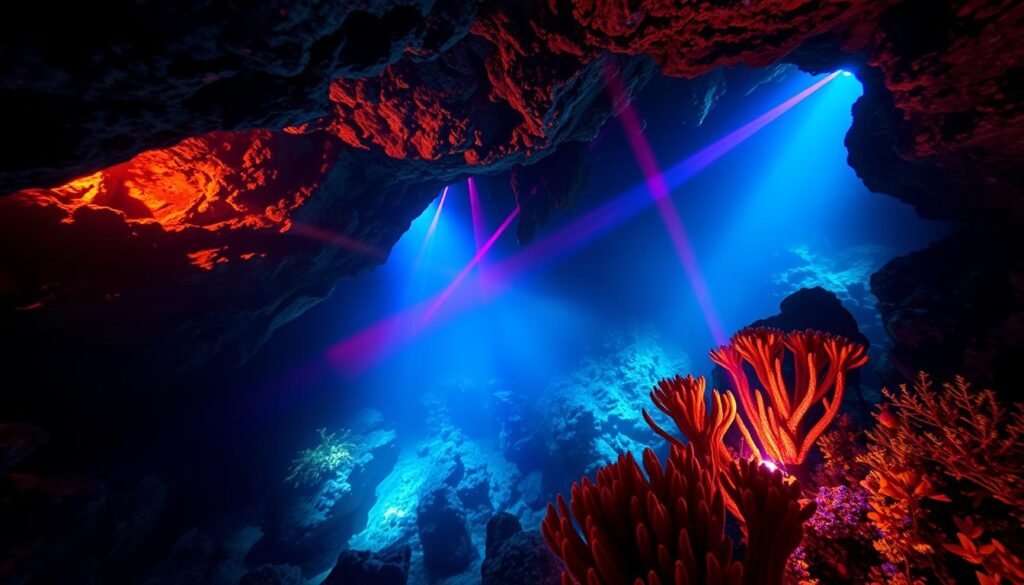
Protective Accessories and Safety Gear
On one of my early cave dives, I got my fins tangled in a fishing line someone had carelessly left behind. Talk about a scary moment! That experience taught me the importance of having the right protective accessories and safety gear. Cave diving can throw unexpected challenges your way, and having tools on hand can turn a dangerous situation into a mere annoyance.
Cutting Tools for Emergencies
A line cutter or shears are must-haves. I carry a small, sharp tool on my BCD. It’s for emergencies, like getting tangled in lines.
Once, it helped free a friend stuck in a crevice. His thanks were worth it. Shears are better than knives underwater because they’re easier to use.
Backup Masks and SMBs (Surface Marker Buoys)
A spare mask might seem unnecessary, but it’s vital. Imagine your main mask breaks. You’ll be squinting and struggling instead of enjoying the dive.
Stashing a spare in your pocket is cheap but can save your dive. An SMB is also important, even in caves. It signals your location if you surface far from the exit.
Hoods, Gloves, and Boots for Protection
You might hit your head or brush against rough surfaces. A hood, gloves, and boots keep you warm and safe. I once got a cut from a rock without gloves. Now, I wear lightweight gloves for dexterity and protection.
Storing Essentials Accessibly
Pockets on your BCD or harness are great. Keep your tools, like a cutting tool and backup mask, there. Easy access is key. Practice finding your tools in a pool to avoid fumbling underwater.
Personal Tips from Hard Lessons
Check your gear after each dive. I inspect my tools and SMB for damage. Once, I found a hole in my SMB before a trip. It was a good catch.
Don’t over-accessorize. Keep your gear simple for safety. This way, you can handle emergencies without hassle.
Protective gear gives you confidence in unexpected situations. It’s like having insurance for your dives. By preparing, you can enjoy the caves more, without worrying about problems.
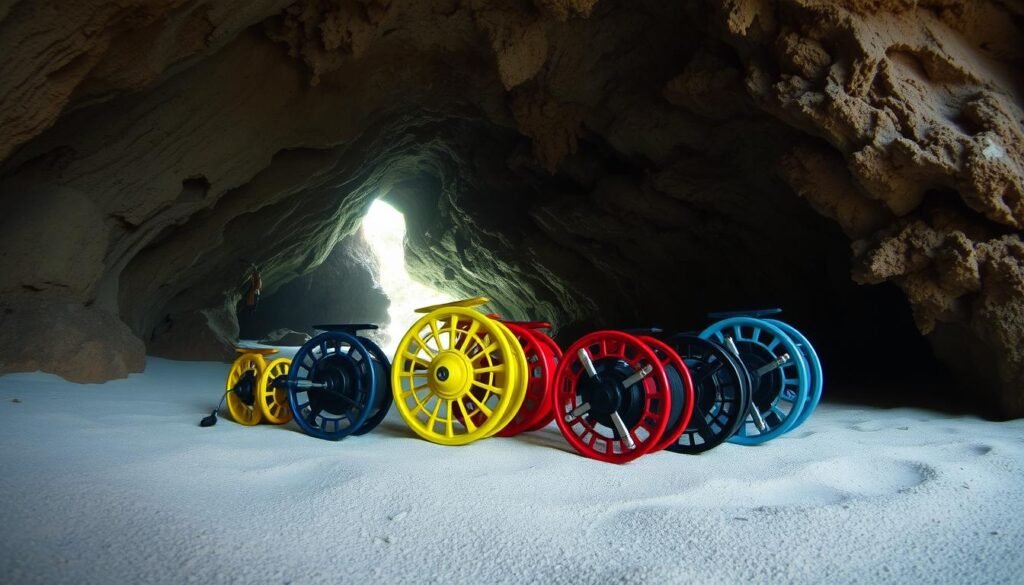
Proper Gear Maintenance and Storage Tips
Bad gear can ruin a dive. Proper care and storage are key. It keeps your gear safe and extends its life. It’s important for many dives to come.
Rinsing and Drying Everything Thoroughly
Salt and silt cling to your gear. Skipping a rinse can damage it. Rinse and soak your gear in fresh water. Hang it to dry in a shaded area.
I once skipped rinsing and regretted it. My gear was damaged, and it affected my next dive. Always rinse and dry your gear properly.
Inspecting O-rings, Hoses, and Lights
A small crack in an O-ring or a frayed hose can lead to a disastrous leak underwater. Always check these parts before every dive trip. Make sure your dive lights are in good shape too—are the O-ring seals clean? Is the battery compartment dry?
One time, I found a hairline crack in my primary light’s lens. Catching that on land meant I could replace it before it turned into an underwater blackout. A quick 5-minute inspection routine can save hours of frustration and potential danger.
Understanding Proper Storage
Storing gear isn’t just about tossing it in a closet until the next adventure. Keep your gear in a cool, dry place, away from direct sunlight. UV rays can degrade materials over time. I once left my wetsuit in direct sunlight for too long, and the neoprene stiffened. Never again.
Use hangers designed for wetsuits and BCDs so they retain their shape. Coil hoses gently and avoid sharp bends. Store masks in protective boxes so they don’t get scratched. A little organization now saves you money and stress down the road.
Annual Professional Servicing
Even if you’re handy, some tasks require a pro. Regulators need yearly service by trained technicians. They check internal parts, lubricate components, and ensure everything’s working smoothly.
The one time I delayed a regulator service, I got a slight free flow at depth. It wasn’t a big deal, but it shook my confidence. After a proper service, the reg felt as smooth as new. Consider it an investment in your safety and peace of mind.
Pro Tips from Personal Experience
Label your gear or store it in designated bags so you don’t lose small accessories. Keep a checklist of what you’ve packed for each trip—fewer surprises at the dive site. Dry bags are great for transport, but make sure everything’s completely dry before sealing it.
If you find a problem, fix it before you forget. That broken fin strap won’t magically repair itself by the next trip. Trust me, I’ve made that mistake and regretted it when I reached the cenote.
By taking the time to maintain and properly store your gear, you ensure it’s always ready to perform at its best. Plus, you’ll save money by not replacing damaged items prematurely. Think of it as nurturing a long-term relationship with your dive equipment—treat it well, and it’ll treat you well in return.
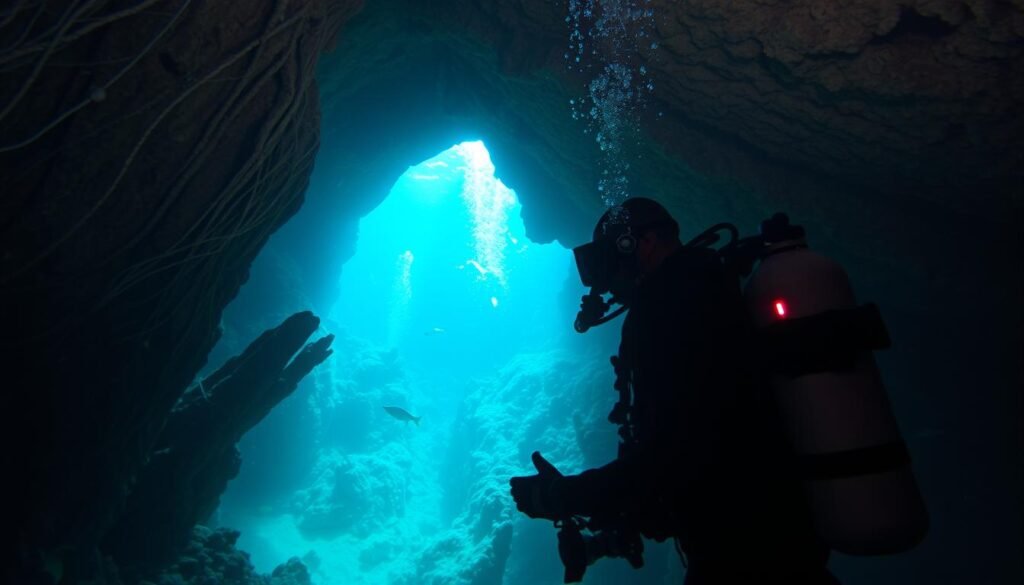
Conclusion
Embarking on a cave diving adventure in Mexico is all about preparation—equipping yourself with gear that enhances safety, comfort, and confidence. By selecting wetsuits that match the local water temps, using high-quality dive lights to illuminate the path, and packing reliable navigation tools, you’re setting yourself up for the dive of a lifetime! Just remember to maintain and care for your equipment, invest in reputable brands, and tailor your gear choices to your personal diving preferences. Ready to take the plunge? Gear up, dive in, and explore Mexico’s hidden underground worlds like a true pro!

